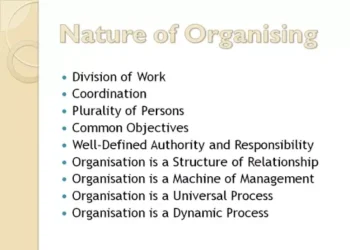Table of Contents:-
- Nature of Organising
- Meaning of Organising
- Definition of Organising
Nature of Organising
From the study of the various definitions given by different management experts, the following information about the characteristics or nature of organising of an organization can be studied:
1) Division of Work
This is the basis of an organisation. In other words, without division of work, there can be no organisation. Under the division of work, the entire work business is divided into many different units. The work of every unit is further subdivided into sub-works.
2) Coordination
Under organising different employees are assigned different work but the aim of all these employees happens to be the same – the attainment of the objectives of the company. The organisation ensures that the work of all the employees depends on each other’s work even though it happens to be different. Hence it helps in establishing coordination.
3) Plurality of Persons
An organisation is a group of many persons who assemble to fulfil a common purpose A single individual cannot create an organisation.
4) Common Objectives
There are distinct units of an organisation with different functions to perform but all move in the direction of achieving a general purpose.
5) Well-defined authority and Responsibility
Under organisation, a chain is established between different posts right from the top to the bottom. It is specified as to what will be the responsibility and authority of every position. In other words, every individual working in the organisation is given some authority for efficient work performance. It is also decided simultaneously as to what will be the responsibility of that person in case of unsatisfactory work performance.
6) Organisation is a Structure of Relationship
A relationship between persons working on different posts in the organisation is decided. In other words, it is decided who will be superior and who will be subordinate. Leaving the top and lowest levels, every employee is somebody’s superior and somebody’s subordinate. The person working in the top-level post has no superior and the person working in the lowest-level position has no subordinate.
7) Organisation is a Machine of Management
The organisation is regarded as a machine of management. It is that machine in which no part can afford to be non-functional or ill-fitting. In other words, if the division of work is not done correctly or posts are not created accurately the whole system of management collapses.
8) Organisation is a Universal Process
The organisation is required both in business and non-business organisations. Not only this, the organisation will be needed where two or more two people work jointly. Hence, an organisation has the quality of universality.
9) Organisation is a Dynamic Process
The organisation is related to people and the knowledge and experience of the people change. The impact of this change affects the different functions of the organisations. Thus, the organisation is not a process that can be decided for all times to come but changes according to the needs. The example, in this case, can be the abolition or creation of a new post according to the need.

Meaning of Organising
Before understanding the concept of organization it is required to know the term “organising”. Organising refers to the process of creating a structure for the organisation that will enable its people to work effectively towards its mission, vision, and goal.
The process of organising consists of assigning the tasks required to achieve the organisation’s goals to the relevant business units, departments, or sections, and then providing the necessary coordination to ensure that these business departments, units, or sections work synergistically. In a small organisation or a small department, this is relatively simple – it is usually a matter of determining which tasks need to be done and allocating them to various subordinates. In large organisations, the process of organising becomes very complex.
It involves dividing the work of the organisation, allocating it logically to business departments, units, and sections, delegating authority, and establishing coordination, communication, and information systems to ensure that everyone is working together to achieve the objectives of the organisation. The organisation refers to the result of the process of organising.
An organisation is a social unit of people that is structured and managed to meet a need or to pursue collective purposes. All organisations have a management structure that determines relationships between the different activities and the members, and sub-divides and assigns roles, responsibilities, and authority to carry out different tasks. Organisations are open systems; they affect and are affected by their environment.
Definition of Organising
According to Ralph C. Davis, “Organisation is a group of people who cooperate under the direction of leadership, for the accomplishment of a common end”.
According to Gary Johns, “Organisations are social inventions for accomplishing goals through group efforts”. Organisation is concerned with the arrangement of work, with the division of activities, and with the allocation of duties, authorities and responsibilities.
